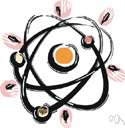neutron
(redirected from Neutrons)Also found in: Thesaurus, Medical, Encyclopedia.
Related to Neutrons: Thermal neutrons, Protons
neu·tron
(no͞o′trŏn′, nyo͞o′-)n. Abbr. n
The electrically neutral nucleon, a baryon composed of two down quarks and one up quark, which has a mass 1,839 times that of an electron, is stable when bound in an atomic nucleus, but has a mean lifetime of 886 seconds as a free particle. It is a basic component of all atomic nuclei except the protium isotope of hydrogen.
American Heritage® Dictionary of the English Language, Fifth Edition. Copyright © 2016 by Houghton Mifflin Harcourt Publishing Company. Published by Houghton Mifflin Harcourt Publishing Company. All rights reserved.
neutron
(ˈnjuːtrɒn)n
(General Physics) physics a neutral elementary particle with a rest mass of 1.674 92716 × 10–27 kilogram and spin ; classified as a baryon. In the nucleus of an atom it is stable, but when free it decays
[C20: from neutral, on the model of electron]
Collins English Dictionary – Complete and Unabridged, 12th Edition 2014 © HarperCollins Publishers 1991, 1994, 1998, 2000, 2003, 2006, 2007, 2009, 2011, 2014
neu•tron
(ˈnu trɒn, ˈnyu-)n.
an elementary particle found in most atomic nuclei, having no charge, mass slightly greater than that of a proton, and spin of ½. Symbol: n
Random House Kernerman Webster's College Dictionary, © 2010 K Dictionaries Ltd. Copyright 2005, 1997, 1991 by Random House, Inc. All rights reserved.
neu·tron
(no͞o′trŏn′) An electrically neutral subatomic particle that is part of the nucleus of an atom and has a mass slightly greater than that of a proton. Beams of neutrons from nuclear reactors are used to bombard the atoms of various elements to produce fission and other nuclear reactions and to determine the atomic arrangements in molecules. See more at atom.
The American Heritage® Student Science Dictionary, Second Edition. Copyright © 2014 by Houghton Mifflin Harcourt Publishing Company. Published by Houghton Mifflin Harcourt Publishing Company. All rights reserved.
neutron
1. One of the three basic particles in an atoms. It is found in the nucleus and has zero charge.
2. A subatomic particle with roughly the mass of a proton and no electric charge.
Dictionary of Unfamiliar Words by Diagram Group Copyright © 2008 by Diagram Visual Information Limited
ThesaurusAntonymsRelated WordsSynonymsLegend:
Switch to new thesaurus
| Noun | 1. |  neutron - an elementary particle with 0 charge and mass about equal to a proton; enters into the structure of the atomic nucleus neutron - an elementary particle with 0 charge and mass about equal to a proton; enters into the structure of the atomic nucleusnucleon - a constituent (proton or neutron) of an atomic nucleus |
Based on WordNet 3.0, Farlex clipart collection. © 2003-2012 Princeton University, Farlex Inc.
Translations
نيوتْرون
neutron
neutron
neutron
neutron
nifteind
neutronas
neitrons
nêutron
neutrón
neutron
Collins Spanish Dictionary - Complete and Unabridged 8th Edition 2005 © William Collins Sons & Co. Ltd. 1971, 1988 © HarperCollins Publishers 1992, 1993, 1996, 1997, 2000, 2003, 2005
Collins English/French Electronic Resource. © HarperCollins Publishers 2005
Collins German Dictionary – Complete and Unabridged 7th Edition 2005. © William Collins Sons & Co. Ltd. 1980 © HarperCollins Publishers 1991, 1997, 1999, 2004, 2005, 2007
Collins Italian Dictionary 1st Edition © HarperCollins Publishers 1995
neutron
(ˈnjuːtron) noun one of the particles which make up the nucleus of an atom.
Kernerman English Multilingual Dictionary © 2006-2013 K Dictionaries Ltd.